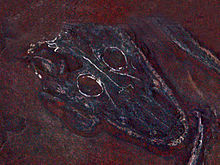Cheliderpeton vrayni
|
Cheliderpeton Temporal range: Early Permian |
|
|---|---|
 |
|
| Fossil skull of Cheliderpeton varyi from Broumov (Czech Republic) at the National Museum (Prague) | |
| Scientific classification | |
| Kingdom: | Animalia |
| Phylum: | Chordata |
| Order: | †Temnospondyli |
| Superfamily: | †Archegosauroidea (?) |
| Genus: |
†Cheliderpeton Fritsch, 1877 |
| Type species | |
|
†Cheliderpeton vrayni Fritsch, 1877 |
|
Cheliderpeton (often misspelled Chelyderpeton) is an extinct genus of temnospondyl amphibian. It lived during the Early Permian in what is now Europe and Germany. Fossils have been found from the Ruprechtice horizon of the Intrasudetic Basin of Bohemia in the Czech Republic, as well as the Saar-Nahe Basin of southwestern Germany. Cheliderpeton had a 16 cm skull, and reached about 65 cm in length.
The type species of Cheliderpeton is C. vranyi, named in 1877 by the Czech paleontologist Antonin Fritsch and found from the Czech Republic. A second species named C. latirostre was described in 1993 by J. A. Boy from Germany, after having been assigned to Archegosaurus. It differs from the type in having a less extensive preorbital region of the skull, a wider cheek region, and a snout tip that is less round and has lateral projections. Currently the two species are the only ones known to belong to Cheliderpeton, although there have been more assigned in the past that are now considered to be synonymous with the known species. "Actinodon germanicus", described by O. Kuhn in 1939 on the basis of a specimen found from the Czech Republic, It is now known to be an unusually large individual of C. vranyi, probably in a late stage of ontogenic development.
It has been suggested that C. latirostre may belong to a separate genus, either to Archegosaurus or its own distinct taxon, due to several differences between it and the type species. These differences include the concave outline of the skull roof, the expanded snout seen in adult individuals (similar to Archegosaurus decheni), and a nasal-maxilla contact in the adult stage. In 2009, C. latirostre was placed in its own genus, Glanochthon.
...
Wikipedia
